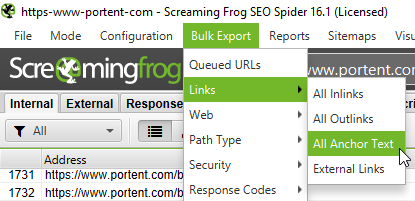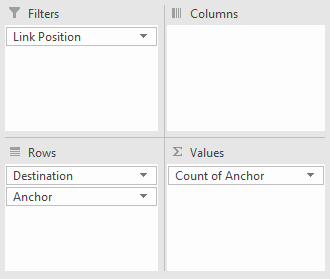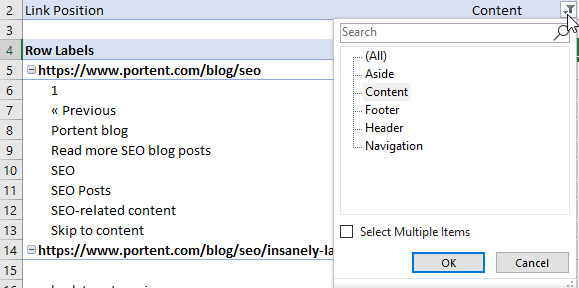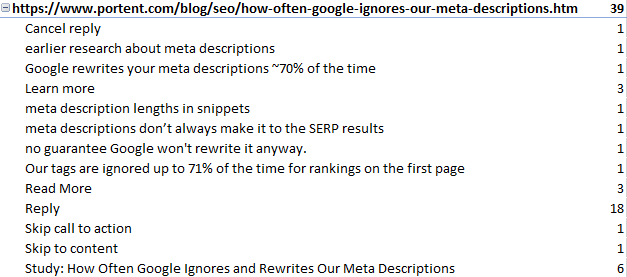It wasn’t that long ago when the web was a somewhat dangerous place. Before there were services like Google’s Safe Browsing (est. 2007), users were a lot more likely to navigate to pages with malware, hacked sites, spam, pornography, and just awful advertising. Remember the days when a page could fill your screen with endless pop-up ad windows? Users rightly became suspicious of the links they were clicking on.
The stakes are lower now, but users are still averse to risk when navigating. For the most part, the everyday risk users will suffer is navigating to an irrelevant page, an unintended page, or being unable to determine which link they should click at all. This is a problem because if users are not confident about clicking links on our pages, they aren’t going to visit many pages and ultimately not convert.
So what’s the easiest way to get users to trust our links? Write descriptive anchor text and make their purpose obvious through context. If users have a pretty good idea of what they will find on the other side of the link, they will see more pages per session and trust our brands more.
Make Internal Links Descriptive
The key to making a link descriptive is helping the user make a good prediction about what will be on the page it takes them to. Applying this idea depends on what kind of link we’re considering and what its purpose is.
Accessibility is also an important factor for descriptive linking. If a website isn’t friendly to assistive technologies, then it may not even be perceptible or navigable.
Here are a few guidelines for the most common types of links on a website:
Main Navigation
Users should be able to look at a website’s main navigation and understand the most important aspects of what the brand does and who it’s for. Making our main navigation fully descriptive can be tough to do since there is little space to work with. We can’t write essays in main navigations.
For individual pages, the link text should try to use the given space to narrow down the page’s purpose. Instead of saying “Products” or “Services,” say what types of products or services, or just list the categories of those. Atmosera does a great job at this when B2B cloud infrastructure brands are often unintelligible to anyone who doesn’t know the jargon:
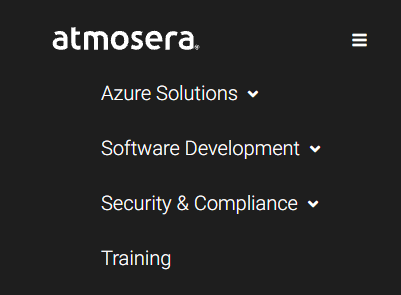
Internal Navigation
Whether it’s in the main content of a page, a sidebar, or a supplemental section, some pages on a website need to act like a directory to other pages. These types of links are the most prone to using generic anchor text like “read more,” “click here,” “learn more,” etc.
Generic link text is a big problem for users relying on screen readers to navigate. If every anchor text describing the pages is “read more,” how can they distinguish between pages? For search engines, it’s a big zero as far as anchor text value is concerned. “Read more” doesn’t help describe any page.

The simple solution to this is to make something else a link, or include what the user will be learning more about. In the above screenshot, the header and subhead text in the card should be in the same link as “read more.” To a user with a screen reader, the “read more” call to action would be in the same context as the description of the linked page.
Contextual Links
When we’re writing a blog post or copy for a product page, we’ll often need to refer to another page or cite the source of a claim. The simplest way to do that is to add links to existing text that link to a page about what we’re referring to or is the source of a claim we’re making. These links should include enough text in the anchor to make the link descriptive and allow the user to infer why we’re linking to it.

In the screenshot above, Porentite Naomi Thalenberg links to the common keyword research tools she mentions in her blog post about how to create content briefs. Below, Jeremiah Bratton refers to guides about using screen readers in his intro guide to web accessibility.

Since our links should use colors that stand out from regular text, we can make calls to action stand out more, like in this example below:

Anchor Text is Also About Keyword Matching
The search engine optimization community has known about the ranking benefits of descriptive anchor text for a long time. The tactic is pretty straightforward: put a page’s target keywords in the anchor text of the links pointing to the page, and it will rank higher for those keywords. Simple!
The practice is simple enough, but what’s the theory behind it? What’s the connection between anchor text and a search query? The simplest search engines rank documents by how often the words in a query appear in their text. The easiest way to incorporate anchor text is to treat the set of all anchors as if it were part of the text in a document. That way, if the anchor text set of a page contains the words in the query a lot, it will rank highly. Seems like a pretty exploitable ranking signal, and it definitely was.
Google Search came to market back in 1998, but anchor text was identified as a reliable ranking signal earlier than that when Brin and Page were working on the BackRub project at Stanford in 1996. Other search engines could have been looking at anchor text earlier than that (Google wasn’t the first web search engine), but the earliest notable date I could find is Yahoo patenting an anchor text approach in 2002.
This means that from 1998 until 2012, when Google rolled out the Penguin algorithm, their search engine was wildly vulnerable to link spammers using manipulative keywords in anchor text. With recent changes to how they handle bad links, the risk for spammers is a lot lower than with classic Penguin. If Google doesn’t like a link, they will simply ignore it. This makes the risk of link spam the same as lighting cash on fire, and I’m seeing a lot more pages with questionable backlinks on the first page.
It must be a very valuable ranking signal to Google if they are willing to put up with so much link spam.
The First Link Priority Rule Still Works, Somewhat
Beyond Google ignoring links it doesn’t like, there is a long-standing limitation for which links will “count.” In the cases where one page links out to another page several times, only the first link will have its anchor text count toward keyword matching of the linked page.
People started calling this phenomenon the First Link Priority Rule, and Rand Fishkin wrote about it pretty well in 2008. In his article, Rand does a test with unique anchor text, which still works.
However, there is an important result of the link priority rule that will affect the way we should conduct anchor text audits: pages we link to in the main navigation will get the same anchor text on every page. Having a descriptive main navigation is very important to the keyword matching signal.
Whenever Google has been asked about the First Link Priority Rule, they usually give the same answer: only the anchor text from the first link counts, but it may not always be that way. If anchor text for keyword matching appears to work the same way since at least 2008, then what has changed?
Where Google Might Be Today Or In The Future
Google probably isn’t using link anchor text just for keyword matching in search, and probably more than the first anchor text string. They have been advancing the fields of natural language processing and machine learning for a long time now, so it’s reasonable to assume they have been applying new techniques to analyzing link text.
Google has a patent that describes a method of extracting “annotation text” from the text surrounding a link. Search Engine Journal has a good interpretation of what this specific patent is for, but Google isn’t necessarily using this method. Usually, patents are better for understanding the types of problems a search engine is trying to solve, and what their technical capabilities might be. In this case, Google wants to use the text surrounding a link to get a better idea of the linked page, which indicates they could be using ways of incorporating the context of a link into their systems.
The original purpose of looking at anchor text is to get a better idea of what a page is about and what its purpose is. Search engines could be using anchor text for determining which topics appear on a page, which locations a page is relevant to, how commercial the content is, and which entities appear.
Search engines might be interpreting the words in anchor text beyond which words they use. Neural network architectures like BERT and its descendants like MUM, map words and sentences to vector representations to better capture the meaning of that text. Since Google uses vector representations of queries in search, they might be looking at anchor text vectors in addition to content vectors to determine when a page is likely to answer a query.
In a more concrete sense, I think Google is better at determining the meaning behind links like this: “Check out our guide to the best backpacking campgrounds in Sierra National Forest.” Using just keyword matching, only “our guide” would apply to how this page is interpreted, but there’s a lot more meaning in this link:
- The page probably talks about the entities backpacking campgrounds and Sierra National Forest.
- The content is a guide and the sentence contains “best,” so it’s probably a good match for queries with informational intent.
- The sentence contains the word “best” so it’s a good match for queries with comparison intent.
If the guide appears for queries like “where to go backpacking in the Sierra Nevada,” then I would attribute it to the newer approaches Google is taking for links, rather than the classic keyword matching paradigm.
Auditing Internal Links for Anchor Text
Now that we have an idea of how search engines could be interpreting link text now and in the future, we need to review our websites.
Examining the anchor text your website uses is pretty easy with Screaming Frog. The real power is in taking its All Anchor Text bulk export and basing a pivot table on it. From there, you can see the most common anchor text for each page. Screaming Frog also identifies where on the page a link is positioned, so we can also filter by navigation, sidebar, footer, and body content locations.
- Start by crawling your website as you normally would. When it finishes, export the All Anchor Text report.

- In your spreadsheet application of choice, insert a new pivot table and configure the rows, values, and filters to show anchor text counts by URL.

- Filter the pivot table down to just the URLs on your domain, then apply any other filters like link position.

- Examine how your important landing pages have been receiving internal links. Are they descriptive? Is there a wider problem on the site with boilerplate anchor text?

After identifying problem links, put in requests to have them fixed on your website. For individual links, I suggest using a tracking sheet like the one in my post about optimizing internal PageRank. Here’s the template for my Internal Link Recommendation sheet.
Google Wants to Rank Useful Websites
After Google launched the Penguin algorithm back in 2012, there were profuse cries of “SEO is truly dead this time!” Yet here we are. What actually died was widespread abuse of a particular ranking signal. Unfortunately, what survived was the notion that the way to rank well in Google is contorting a website to unnaturally game a few ranking signals.
That view of SEO should be dead. Instead, we should be thinking about what search engines’ goals are for results: they want to identify the pages that are truly worth showing to users, and order them by how well they fit a query.
For the organic search marketer, SEO should instead mean two things:
- Content should be valuable to users and fulfill some need
- The purpose and value of our content should be obvious to users and search engines
This article is about the second point. Descriptive anchor text helps make purpose and value obvious.


